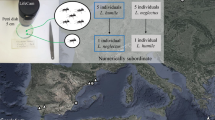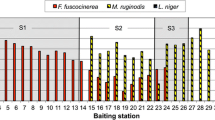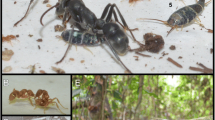Abstract
We examined intraspecific colonial aggressiveness in Wasmannia auropunctata (Roger), a tramp species originating from the neotropics. By observing the results of one-on-one confrontations, we compared the behavioral responses of workers originating from six New Caledonian locations (introduced range) and four Brazilian cocoa plantations (original range). We recorded interindividual “aggressive” behavior on four levels ranging from physical contact, with no aggressive response, to prolonged aggressiveness, including stinging by one or both ants. In Brazil, we often observed high intraspecific aggressiveness between populations originating from distant locations, indicating that W. auropunctata may behave as a multicolonial species in its native range. In New Caledonia, paired encounters resulted in low agonistic behavior, as shown by the absence of “full attacks” (which include stinging by one or both opponents). Our results suggest that W. auropunctata behaves as a single supercolony throughout New Caledonia and that the scale of its unicoloniality (widespread colonies with interconnected nests without aggressiveness between workers originating from distant areas) is different in introduced and native populations. According to the present study, it seems likely that differences in intraspecific aggressiveness between native and introduced populations of W. auropunctata contribute to its invasive success.
Similar content being viewed by others
REFERENCES
Clark, D. B., Guayasamín, C., Pazmiño, O., Donoso, C., and Páez de Villacís, Y. (1982). The tramp ant Wasmannia auropunctata: Autecology and effects on ant diversity and distribution on Santa Cruz Island, Galapagos. Biotropica 14: 196-207.
Delabie, J. C. (1990). The ant problems of cocoa farms in Brazil. In Vander Meer, R. K., Jaffe, K., and Cedeno, A. (eds.), Applied Myrmecology, a World Perspective, Westview Press, Boulder, pp. 555-569.
Delabie, J. H. C., Encarnaçao, A. M. V., and Cazorla, I. M. (1994). Relations between the little fire ant, Wasmannia auropunctata, and its associated mealybug Planococcus citri in Brazilian cocoa farms. In Williams, D. F. (ed.), Exotic Ants: Biology, Impact, and Control of Introduced Species, Westview Press, Boulder, pp. 91-103.
Delabie, J. H. C., Agosti, D., and Nascimento, I. C. (2000). Litter ant communities of the Brazilian Atlantic forest region. In Agosti, D., Majer, J., Alonso, L., and Schultz, T. (eds.), Sampling Ground-Dwelling Ants: Case Studies from the Worlds' Rain Forests, Curtin University School of Environmental Biology, Perth, Bull. No. 18, pp. 1-17.
Fabres, G., and Brown, W. L. (1978). The recent introduction of the pest ant Wasmannia auropunctata into New Caledonia. J. Aust. Entomol. Soc. 17: 139-142.
Giraud, T., Pedersen, J. S., and Keller, L. (2002). Evolution of supercolonies: The Argentine ant of southern Europe. Proc. Natl. Acad. Sci. USA 99: 6075-6079.
Holway, D. (1999). Competitive mechanisms underlying the displacement of native ants by the invasive Argentine ant. Ecology 80: 238-251.
Holway, D. A., Suarez, A. V., and Case, T. J. (1998). Loss of intraspecific aggression in the success of a widespread invasive social insect. Science 282: 949-952.
Holway, D., Lach, L., Suarez, A. V., Tsutui, N. D., and Case, T. J. (2002). The causes and consequences of ant invasions. Annu. Rev. Ecol. Syst. 33: 181-233.
Human, K. G., and Gordon, D. M. (1999). Behavioral interactions of the invasive Argentine ant with native ant species. Insectes Soc. 46: 159-163.
Jourdan, H. (1997). Threats on Pacific islands: The spread of the tramp ant Wasmannia auropunctata (Hymenoptera: Formicidae). Pac. Cons. Biol. 3: 61-64.
Jourdan, H., Sadlier, R.A., and Bauer, A. M. (2001). The impact of the little fire ant invasion (Wasmannia auropunctata (Roger)) on the New Caledonian herpetofauna: results of a study in sclerophyll forest habitat. Sociobiology 38: 283-301.
Jourdan, H., Bonnet de Larbogne, L., and Chazeau, J. (2002). The recent introduction of the neotropical ant Wasmannia auropunctata (Roger) into Vanuatu archipelago (Southwest Pacific). Sociobiology 40: 483-509.
Le Breton, J., Chazeau, J., and Jourdan, H. (2003). Immediate impacts of invasion by Wasmannia auropunctata (Hymenoptera: Formicidae) on native litter ant fauna in a New Caledonian rainforest. Austral. Ecol. 28: 204-209.
Lowe, S., Browne, M., and Boudjelas, S. (2000). 100 of the world's worst invasive alien species. Aliens 12S: 1-12.
Majer, J. D., and Delabie, J. H. C. (1999). Impact of tree isolation on arboreal and ground ant communities in cleared pasture in the Atlantic rain forest region of Bahia, Brazil. Insectes Soc. 46: 281-290.
Majer, J. D., Delabie, J. H. C., and Smith, M. R. B. (1994). Arboreal ant community patterns in Brazilian cocoa farms. Biotropica 26: 73-83.
Majer, J. D., Delabie, J. H. C., and McKenzie, N. L. (1997). Ant litter fauna of forest, forest edges and adjacent grassland in the Atlantic rain forest region of Bahia, Brazil. Insectes Soc. 44: 255-266.
Passera, L. (1994). Characteristics of tramp species. In Williams, D. F. (ed.), Exotic Ants: Biology, Impact, and Control of Introduced Species, Westview Press, Boulder, pp. 23-43.
Ryti, R. T., and Case, T. J. (1988). Field experiments on desert ants: testing for competition between colonies. Ecology 69: 1993-2003.
Suarez, A. V., Tsutsui, N. D., Holway, D. A., and Case, T. J. (1999). Behavioral and genetic differentiation between native and introduced populations of the Argentine ant. Biol. Invasions 1: 43-53.
Tsutsui, N. D., Suarez, A. V., Holway, D. A., and Case, T. J. (2000). Reduced genetic variation and the success of an invasive species. Proc. Natl. Acad. Sci. USA 97: 5948-5953.
Tsutui, N. D., Suarez, A. V., and Grosberg, R. K. (2003). Genetic diversity, asymmetrical aggression, and cooperation in a widespread invasive species. Proc. Natl. Acad. Sci. USA 100: 1078-1083.
Ulloa Chacón, D., and Cherix, D. (1990). The little fire ant Wasmannia auropunctata (Roger)(Hymenoptera: Formicidae). In Vander Meer, R. K., Jaffe, K., and Cedeno, A. (eds.), Applied Myrmecology: A World Perspective, Westview Press, Boulder, pp. 281-289.
Wilson, E. O. (1971). The Insect Societies, Harvard University Press, Cambridge, MA.
Author information
Authors and Affiliations
Corresponding author
Rights and permissions
About this article
Cite this article
Breton, J.L., Delabie, J.H.C., Chazeau, J. et al. Experimental Evidence of Large-Scale Unicoloniality in the Tramp Ant Wasmannia auropunctata (Roger). Journal of Insect Behavior 17, 263–271 (2004). https://doi.org/10.1023/B:JOIR.0000028575.28700.71
Issue Date:
DOI: https://doi.org/10.1023/B:JOIR.0000028575.28700.71




